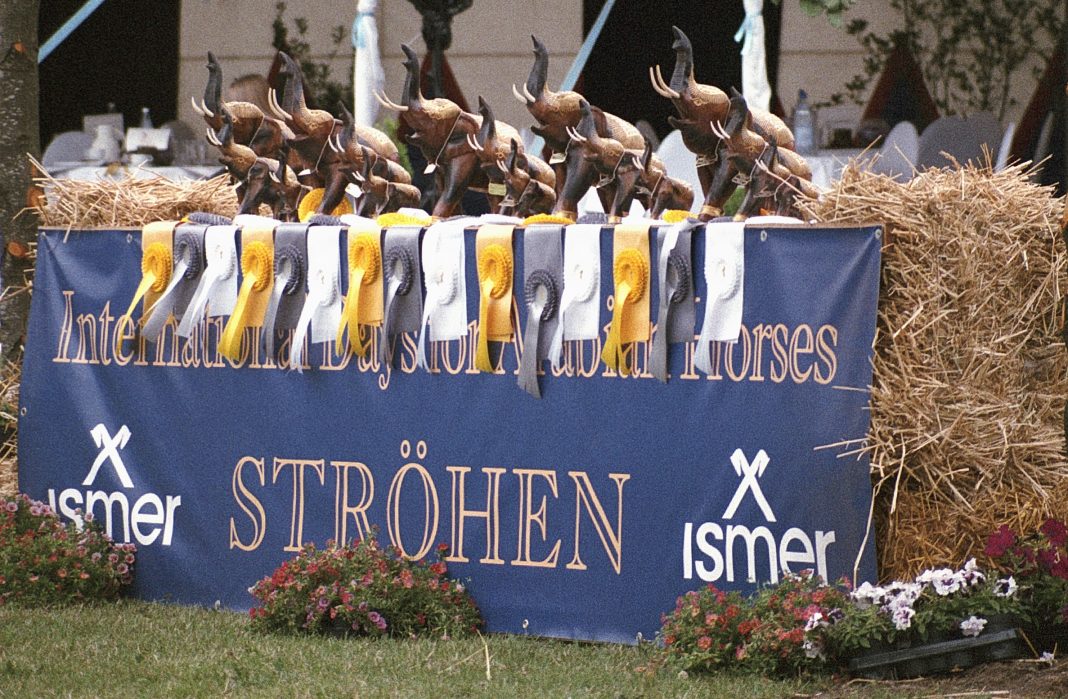Every year on a weekend in July the Ismer Stud hosts two Arabian Horse Shows. In 2019 they were an International B-Show on Saturday 13 July and a European C-Show on Sunday 14 July. Attending this show weekend regularly since 2009, I usually arrive at the showground at noon. Therefore I miss the classes in the morning and this will explain why one or another horse might not been mentioned in my following selection of Arabian horses that were presented at Ströhen 2019.
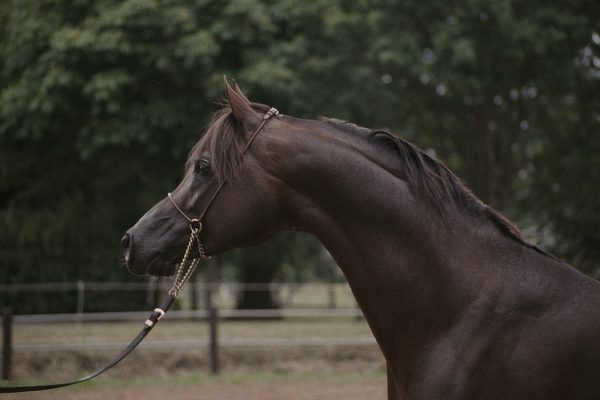
CA Evoque
Redwood Lodge Essine x Bess-Hariyah by Psymagin – born 2013
Breeder: Calbar Arabians, Denmark
Owner: Sabrina Johansen, Denmark
Trainer: Alexandra Siana
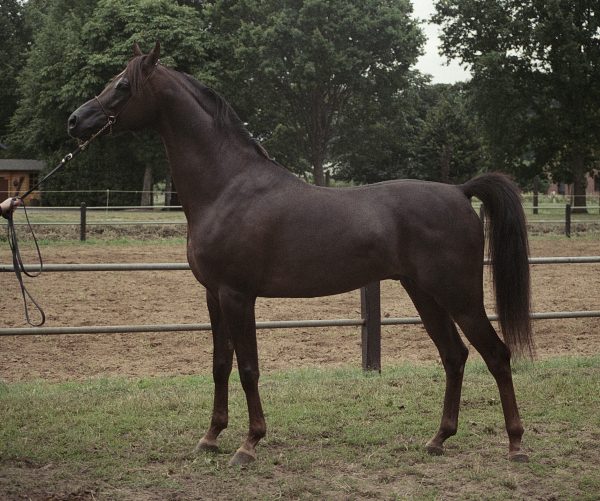
CA Evoque already had my attention at the Ströhen Show in 2017 when he was just four years old. So I very much looked forward to seeing him again…
There are stallions who have the aura that touches you right at the moment when they leave the stable tent and walk the hundred metres down to the collecting area of the showground. These are stallions with a true natural masculine appearance, and for me CA Evoque belongs to this category.
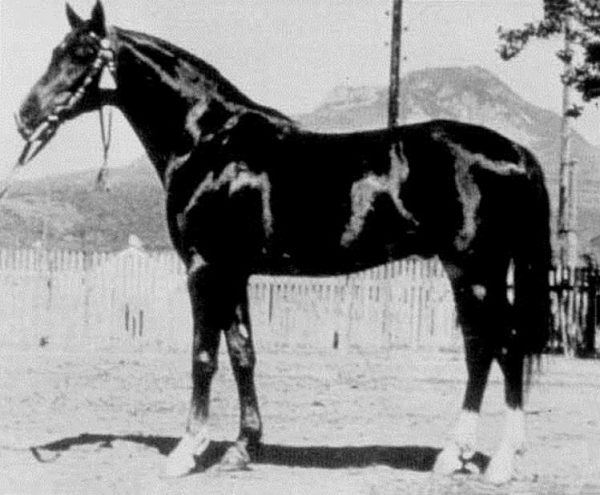
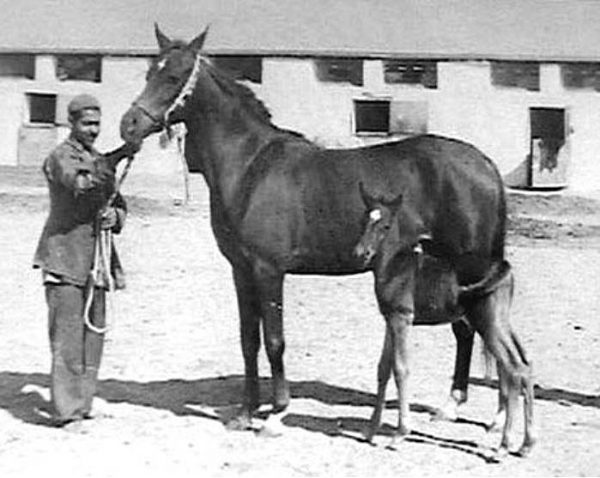
![]()
![]()
Considering his sire and dam, I would assume this type of a liver chestnut horse was not really intended by the breeder. Sometimes very early ancestors can ‘awake’ spontaneously after a long, deep ‘genetic sleep’ through the generations. But this isn’t the case in regard to CA Evoque.
At first he reminded me of Plakat (Aswan x Pchelka), since there are two crosses to him in the pedigree. My next thought was, where does the coat colour come from? Perhaps it is Shaker el Masri (Morafic x Zebeda) because of several crosses? But, no, this one was the wrong shade of chestnut. In breeding horses, another very interesting genetic phenomenon can occur. I often find cases where horses look as if two of their ancestors had been mated. So, if you are not driven by wishful thinking, you may be able to gain some useful breeding information by investigating a pedigree.
My favoured conclusion in CA Evoque’s case is the ‘mating’ of Wanisa (dam of Moniet el Nefous) and Knippel (a very famous race horse of Tersk).
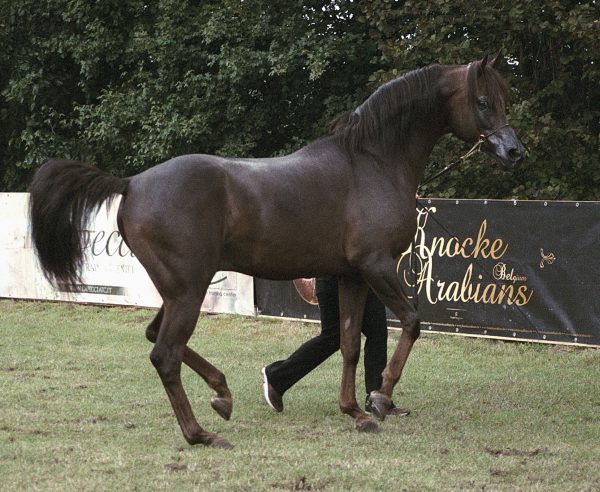
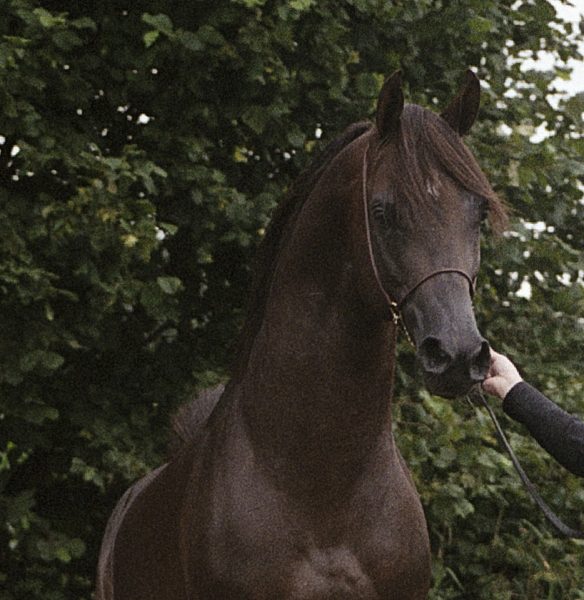
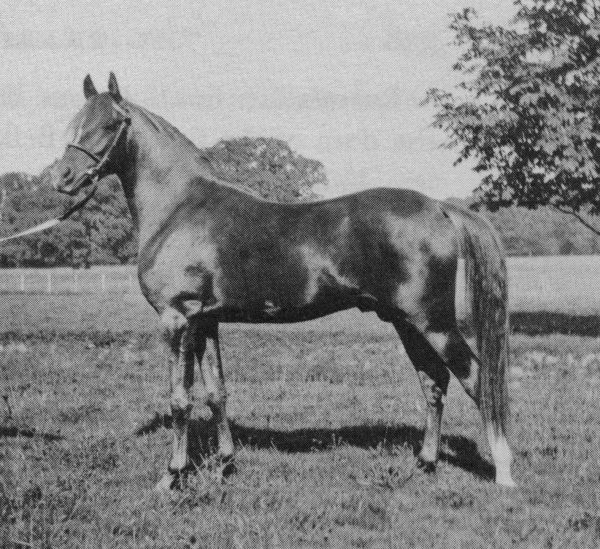
A ![]()
A good horse of course doesn’t have a colour! But I have to confess, that I like liver chestnut very much, the darker the better. Therefore I was interested to find the source of CA Evoque’s colour. The trail leads via two crosses to Cinders (Algolson x Yateemah) in a mating of two half siblings, to Rissam. This stallion is said to be the origin of the beautiful liver chestnuts in Great Britain.
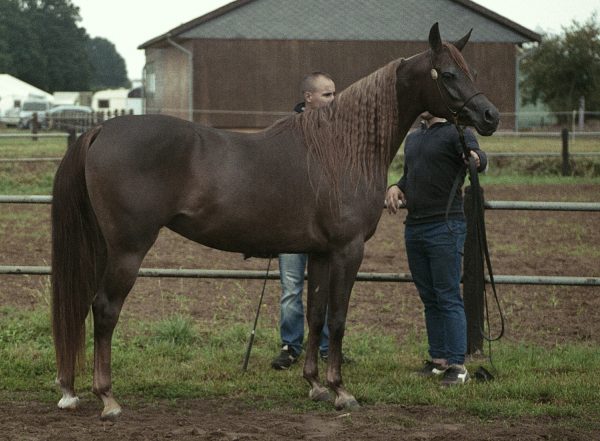
D Khattafah
Royal Colours x D Jowan by Marwan Al Shaqab – born 2015
Breeder: Dubai Arabian Horse Stud, United Arab Emirates
Owner: Al Jawaher Arabian Horse Stud, United Arab Emirates
Trainer: Capecci Arabian Training Center
D Khattafah, as captured in the above photo, is not a twisted and dyed fake. She is genuine. Look at this mare!
Her type, in the original meaning of this term, made me think she is a “Russian” liver chestnut by the Crabbet bloodlines, but this was the wrong trail. The review of her sire line brought clarity why her type seemed so familiar to me. In 1993 I visited the Hungarian state stud Babolna and therefore I know the look of Ibn Galal’s (Galal x Mohga) descendants. In the 5th generation hides a granddaughter, the black Bahila (Ibn Galal x Bakria by Gharib).
In conclusion, D Khattafah is the consolidation of the Egyptian lines from Babolna and Tersk by building a cluster of the liver chestnut Ibn Rabdan (Rabdan El Azrak x Bint Gamila) in the pedigree.
To complete the picture, it should be mentioned that Rissalma’s (Shareer x Rissla) famous “Russian” son Priboj is of course not missing among the ancestors.
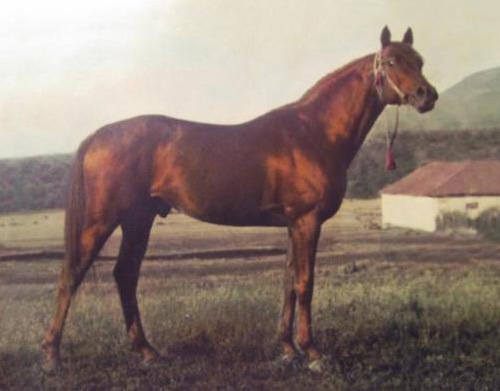
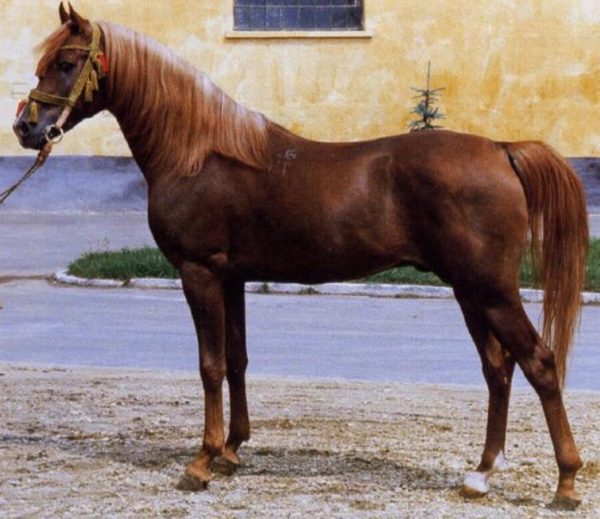
![]()
![]()
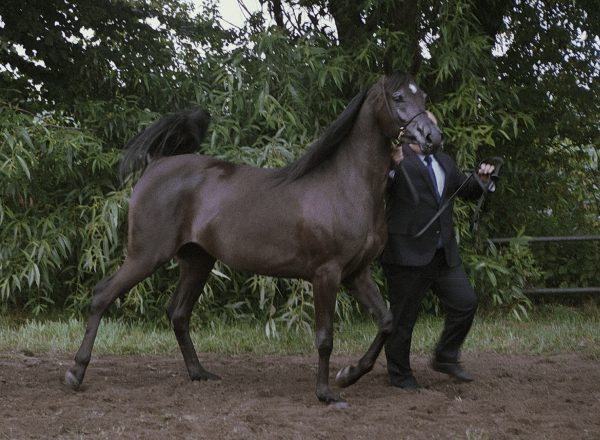
Namirah KA
Tajj x Naminah Bint Nadjhan-D by Nadjhan Ibn Piwonia-D – born 2015
Breeder: Klarenbeek Arabians, The Netherlands
Owner: Black Lady Arabians, Poland
Just when I arrived at the show ground I spotted this ‘black lady’ in the show-ring and this photograph of her is the only one I could catch, when she left the ring after the class. This remarkable mare is a ‘black out of the blue’. Within nine generations of her pedigree, which results in a total of 1022 ancestors, there are only 10 black horses as displayed here:
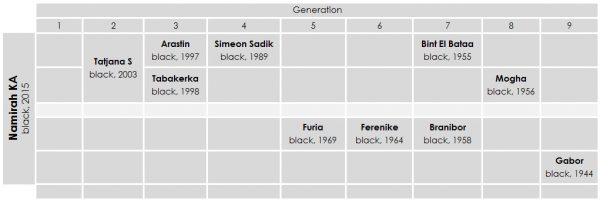
A 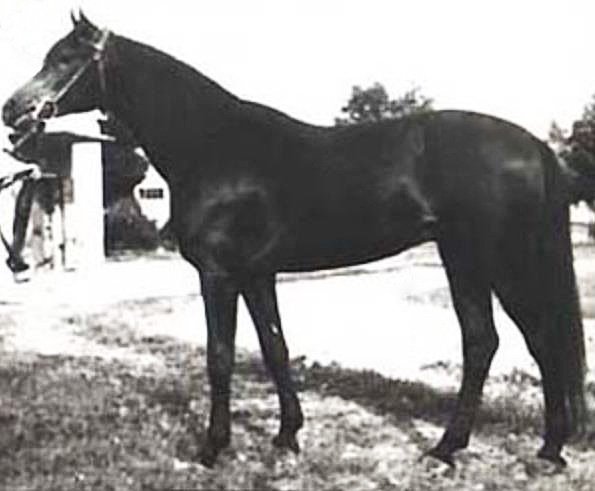
A ![]()
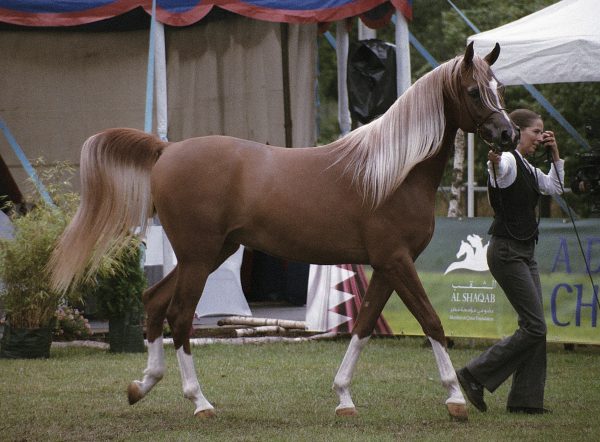
BS Kadjar
BS Karanji x Sherruka Al Roban by FS Bengali – born 2017
Breeder: Brigitte Sprave, Germany
Owner: Brigitte Sprave, Germany
Trainer: Jan Calis – presented by Johanna Ullström
The now late Jan Calis saw me taking photos of BS Kadjar and asked me: “Do you like him?” My answer was “Why not?”. Actually there isn’t that much to criticise about this distinctive blond youngster. What I didn’t know at that time was that Jan would soon be the owner of BS Kadjar. This is surprising, since the stallion represents fashionable show breeding lines, on which Jan never before had set his focus on as a breeder.
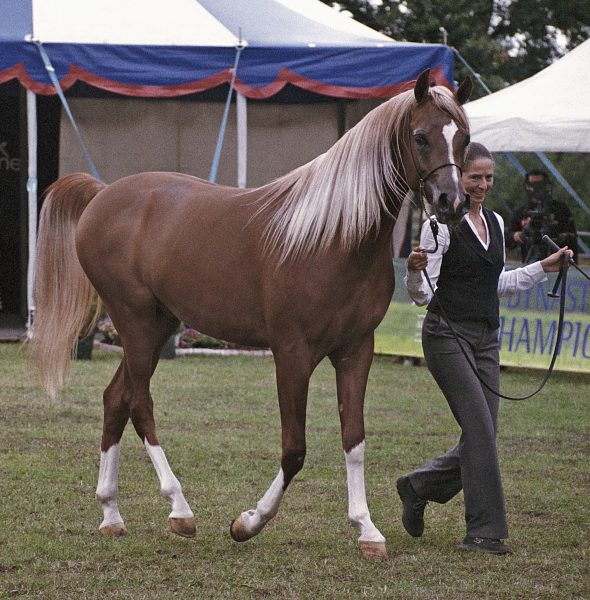
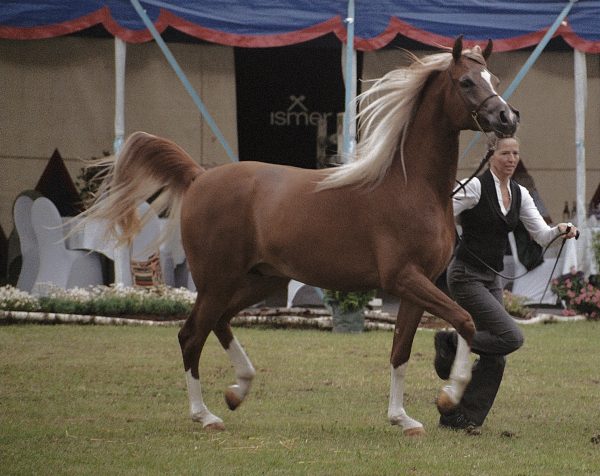
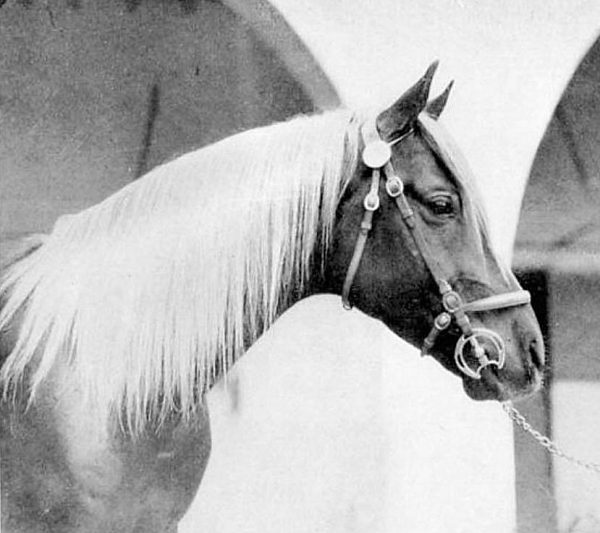

![]()
![]()
By this time you are surely aware that I enjoy following the trail where a type and a colour of a horse origins from. And in the crowd of near-identical Show-Arabians, the look of BS Kadjar is refreshingly different. The mare Renea (Jassen x Shamillazzan) in the 5th Generation opens the ‘gate’ to the branch of ancestors of BS Kadjar that represent the lasting influence of two ‘blondes’ from the desert: Haffia d.b. (imported to the USA by Homer Davenport) and Rodania d.b. (taken to Crabbet Park by the Blunts in 1881).
I passed on without actually counting the numerous occurrences of Rodania d.b. and focused on the more defining mare in this case, which I think is Haffia d.b..
Four lines in Renea’s pedigree originate from Haffia d.b., and three of these via Haffia’s very influential grandson Antez. He has an interesting connection to Rodania d.b. via his other grandam Wadduda d.b., another desertbred mare imported to the US by Homer Davenport. Examination of the mtDNA of Rodania’s and Wadduda’s descendants has proved that both mares share the same dam line.
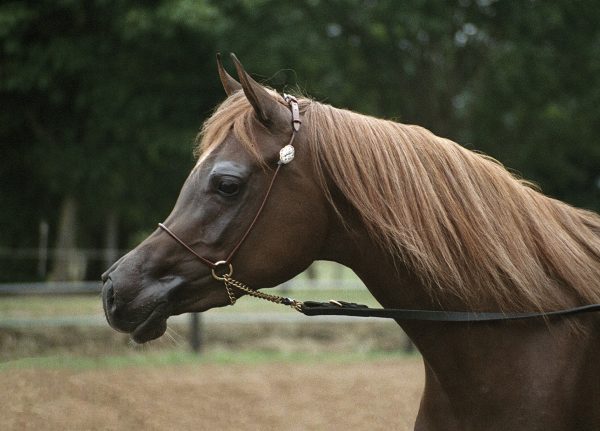
TA Karenza
Nabucco K x JV Karubi by El Sid – born 2017
Breeder: Tärenäs Arabian Stud, Sweden
Owner: Tärenäs Arabian Stud, Sweden
Trainer: Johanna Ullström
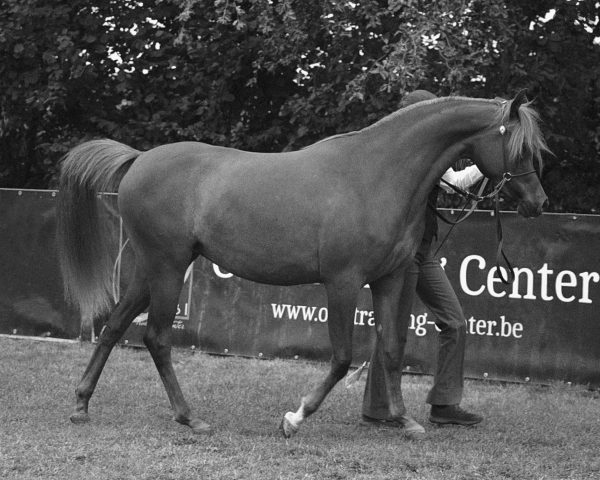



The lovely little mare TA Karenza shows recognisable features of Patron. The legendary, beautiful and famous sire was a proven race horse, who links distinct bloodlines of desert bred imports of various countries in his pedigree: Egypt, Poland, Great Britain and France. You will find two crosses to him in TA Karenza’s sire line.
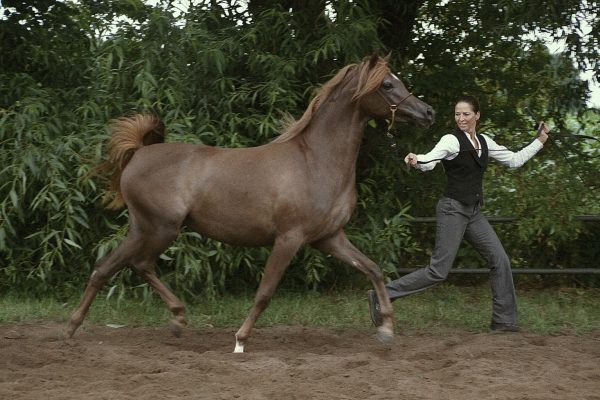
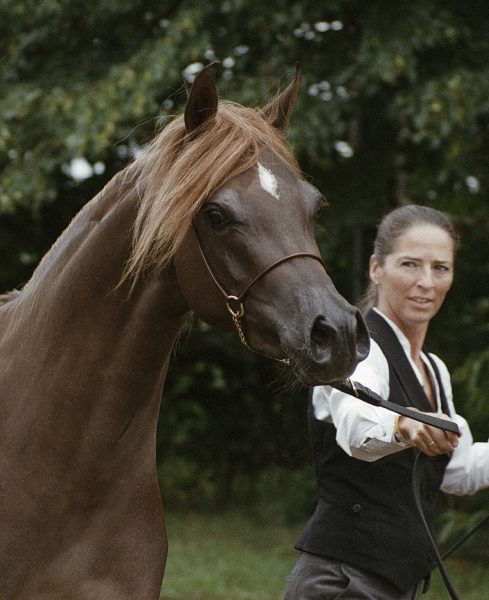
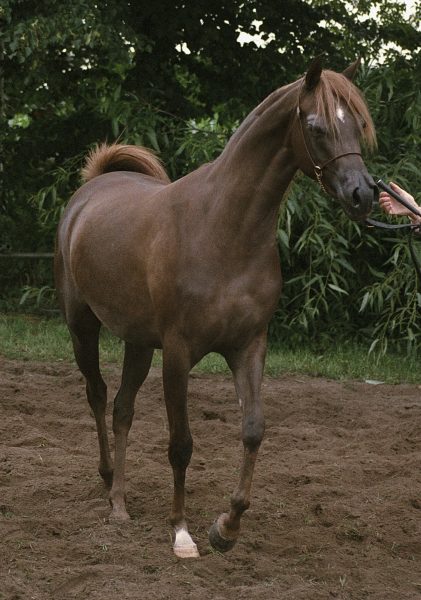
The judges
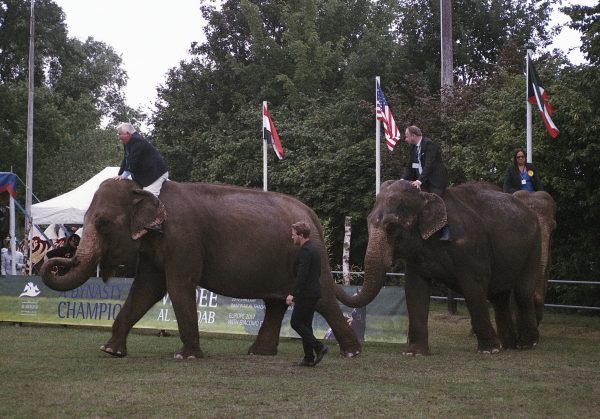
Some years ago the Ismer family, who also run a zoo, had to give up their own African elephants that had grown up at zoo. So the tradition that the judges return from the lunch break to the main ring on Sunday on the back of elephants came to an end. Until last year, when the judges returned to the ring by riding three Indian elephants that spend their ‘summer holidays’ at the Ströhen Zoo. Elvis Errani demonstrated the adorable character of his stars, the 2009 winners of the Bronze Clown at the Festival du Cirque de Monte Carlo!
The judges riding the elephants (from left to right): ‘George Z’, Jerzy Zbyszewski (USA); Tomasz Tarczynski (Poland); and Chen Kedar (Israel).
A 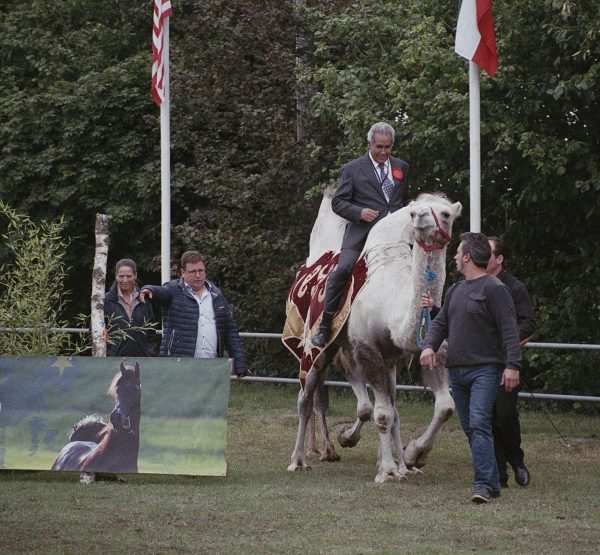
Ali Shaarawi (Egypt) chose as an alternative the ride on a beautiful two-humped camel owned by the circus family Frank, who guest at the Ströhen Circus Shows with various attractions. Dr Nils Ismer (left) showed the right way where to go, just alongside the VIP tent.
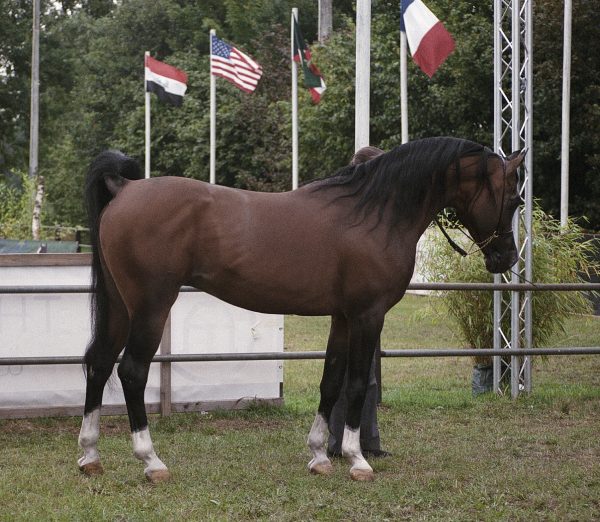
BS Mashallah
QR Marc x FS Mona Lisa by Shakaar Ibn Sanadiva – born 2009
Breeder: Brigitte Sprave, Germany
Owner: Jan Calis, The Netherlands
Trainer: Jan Calis – presented by Johanna Ullström
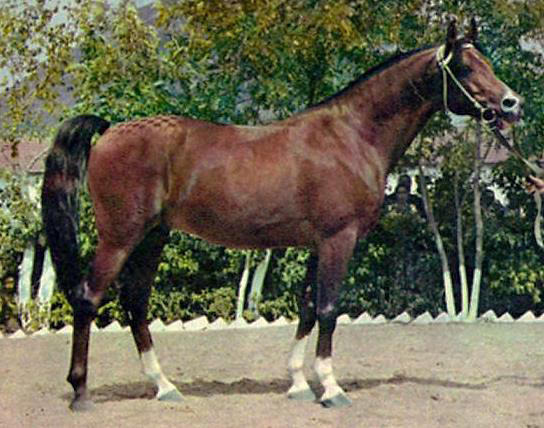
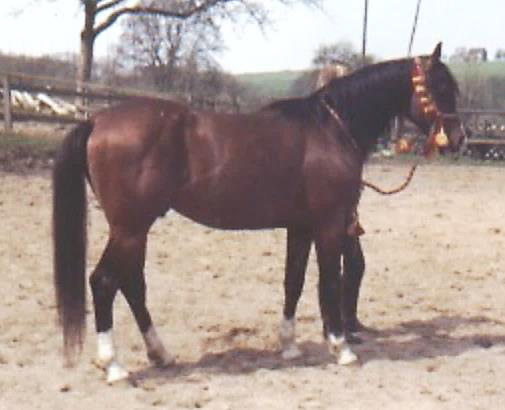
![]()
![]()


That BS Mashallah looks like he does is not really surprising. His dam descends by 75% from the two lookalike full siblings FS Bengali (Kubinec x Om El Sanadiva) and Shakaar Ibn Sanadiva. By checking the ancestry background in general, I found multiple times Arax, two times Khemosabi and one time Witel. The thing is, the longer I look at BS Mashalla’s photo the more I see him corresponding to ‘Witel’ than to the other two. By going further back in time, I found the picture of the almost perfect riding horse Rasim III in this part of the pedigree. This stallion displays excellently which quality features got lost by mainly focusing on breeding the heads of the modern show Arabians.
A 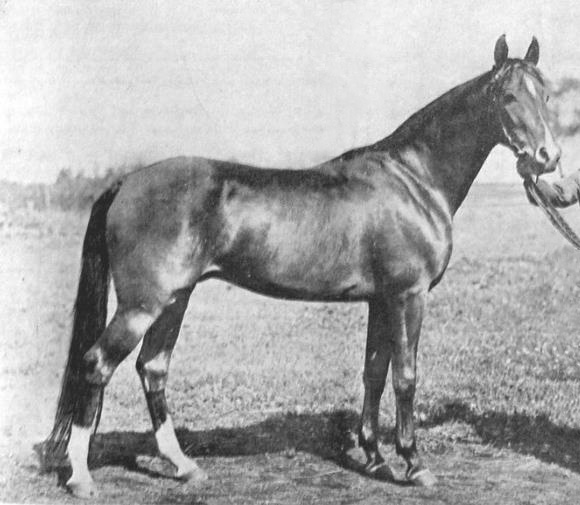
A ![]()
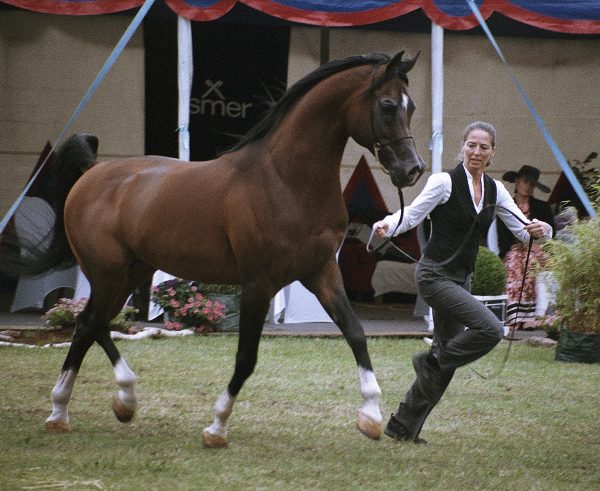
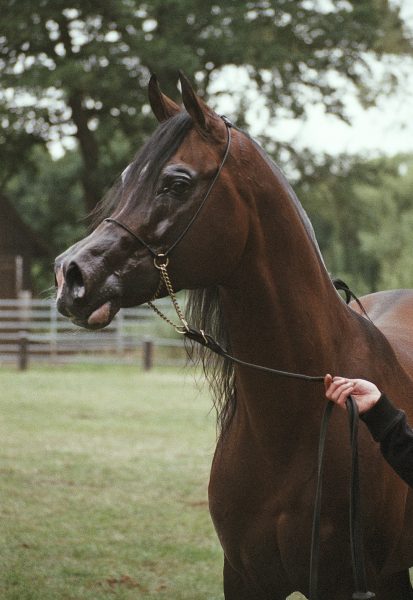
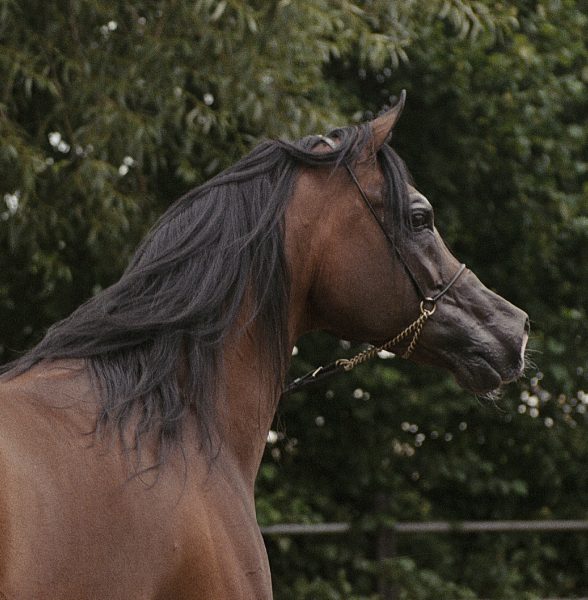
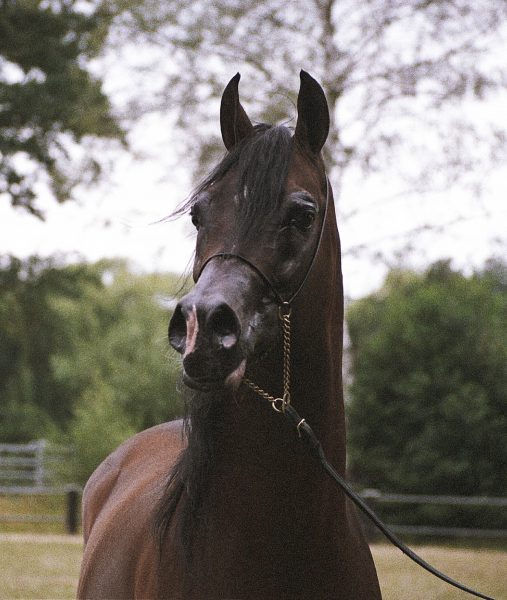
But BS Mashallah also has a strong chestnut female line. So his chestnut offspring might perhaps show some likeness to Mansul, the foundation sire of the former Saalegrund Stud. In the early 1980s Mansul was an icon of the shows at Aachen. Long before you saw him, his stallion roar made quite clear to the male competitors who the master of the showground was.
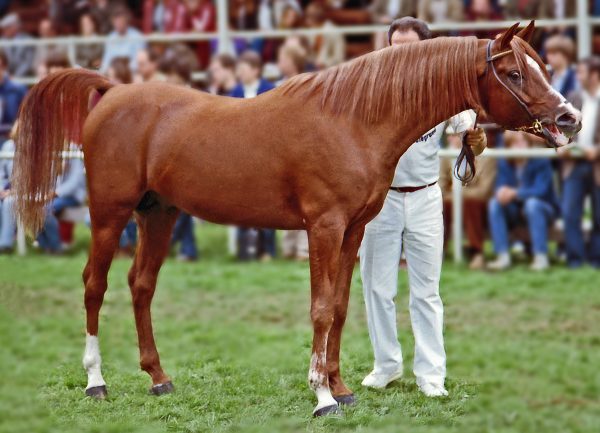
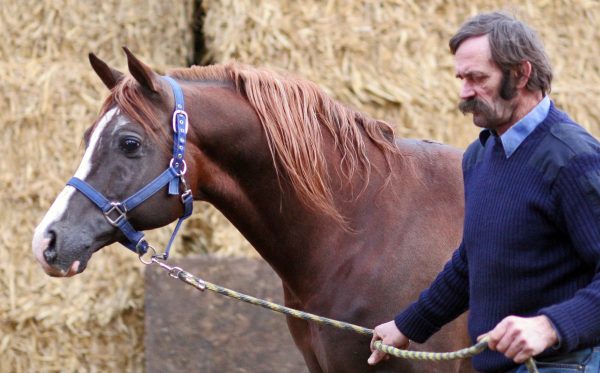
![]()
![]()
Sadly Jan Calis passed away in November 2019. For the last forty years, it was not possible to imagine the Arabian horse show scene without him. But as a breeder he went his personal and different way. His purebred Arabians had to be strong riding horses and he kept a close partnership with the Russian Tersk Stud by purchasing and exchanging stallions.
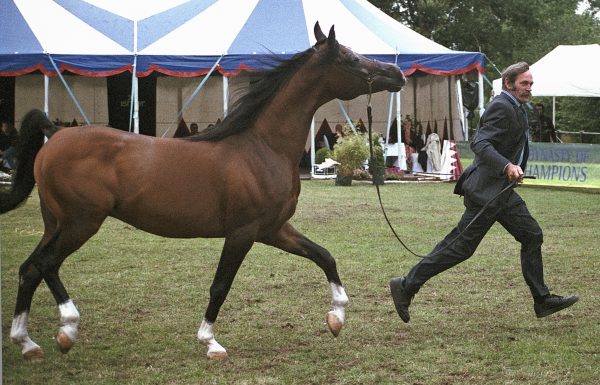
One of my last photos of Jan and according to his nickname, it shows him ‘flying’.
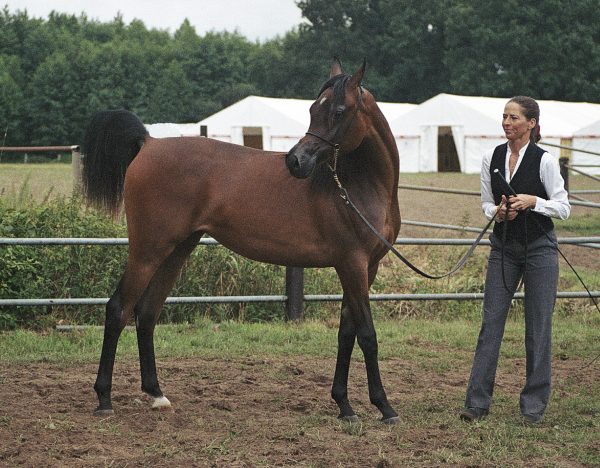
IS Wayana
Poseidon OS x IS Wimea by El Mariachi – born 2018
Breeder: Ismer Stud, Germany
Owner: Eriska Arabians, United Kingdom
Trainer: Johanna Ullström
‘Perfection’ would have been an appropriate name for IS Wayana’s sire. But the name of the Greek god of the sea, brother of Zeus and one of the twelve Olympic gods, POSEIDON, fits excellently in regard to this stallion’s quality as horse AND sire.
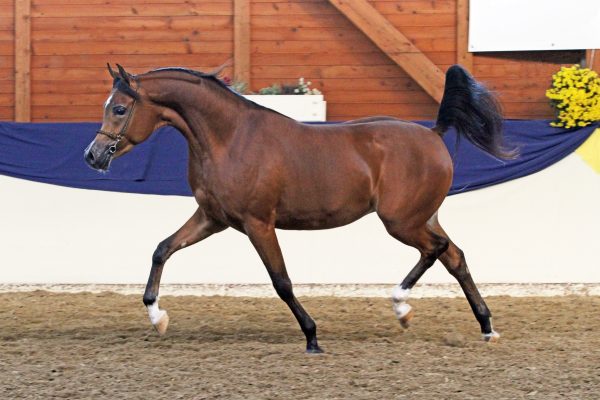
Poseidon OS (Ajman Moniscione x Maryah OS), 2013
VZAP stallion licensing in 2015, photo by Betty Finke
There is every indication that pretty little IS Wayana is a good choice for a stud as a future broodmare. Since the German girl has been sold to British breeders, I would love to see her covered by AH Kuda (Pilot x My Midnite Dancer) one day. This would give the genetic wheel of fortune a chance to connect with the black line of Sharima III (BS Summerset x Soraya El Assuad) and the black Branibor (see above) on the female side of IS Wayana’s pedigree, by keeping the quality on a high standard.
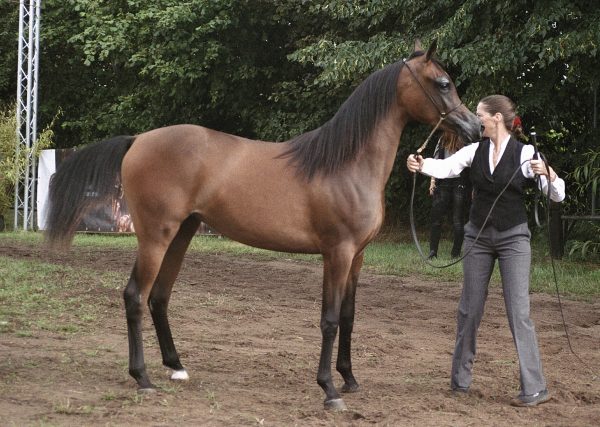

A 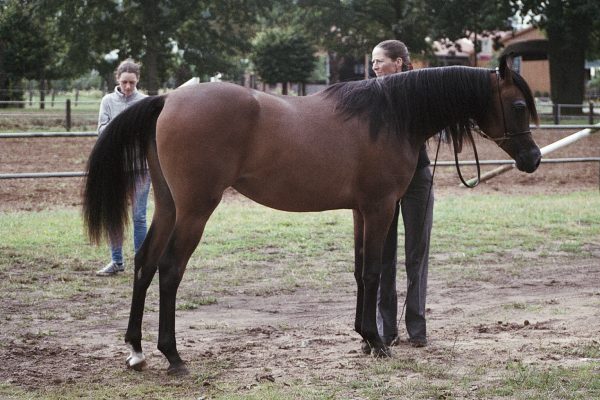
Score statistic
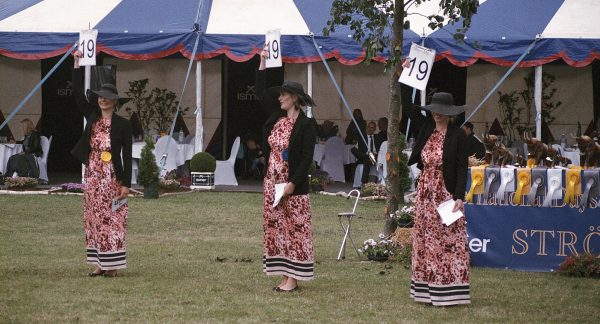
Decades ago I lost interest in the judging at Arabian shows. More and more I had the impression that the time of ‘disillusioning judgements’ came to an end and changed to kind diplomatic standard scores. To prove my personal impression for this article, I did a statistical analysis on the scores of the European Show. The results are displayed below:
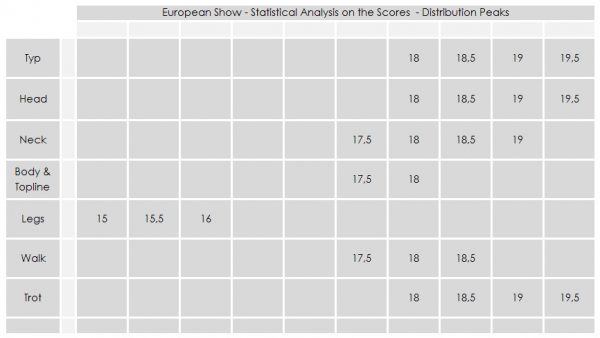
Just in case you want to know, or you have the ambition to breed legs worth a score of, let’s say, 18 for the show-ring, then the following photos can give you an impression. And, sorry to say, but to find such legs you have to go back in time.
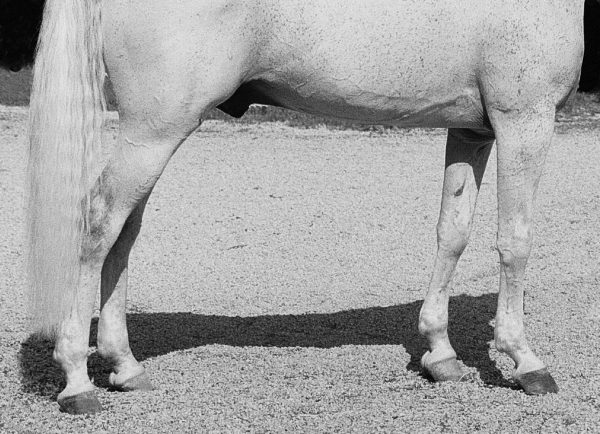
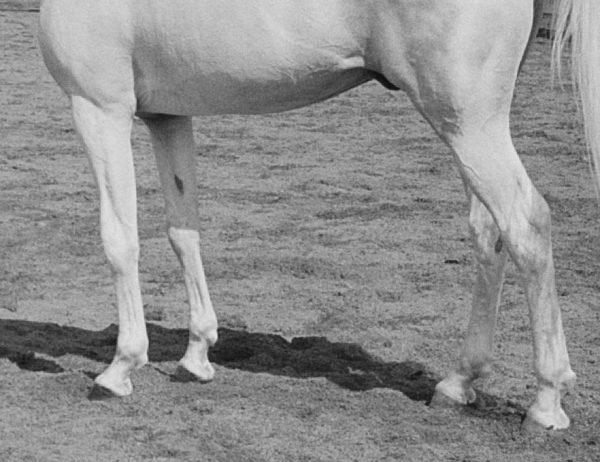
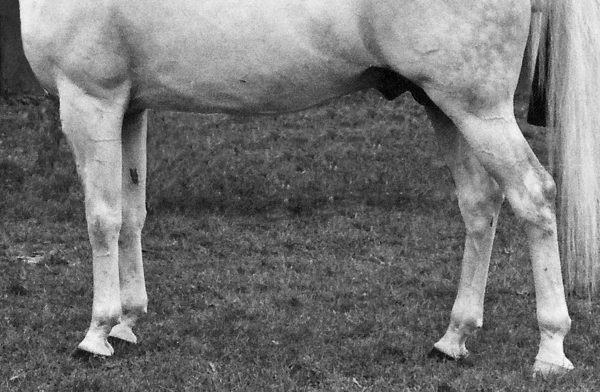

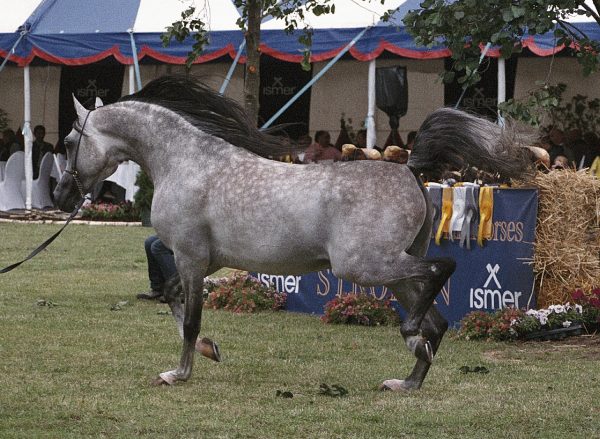
Matiullah Khan
Abha Qatar x Zarqa Moefezaa’a by Hlayyil Ramadan – born 2011
Breeder: Nathalie van Geloven, The Netherlands
Owner: Fysio Arabians, The Netherlands
Trainer: Chris van Schalkwijk
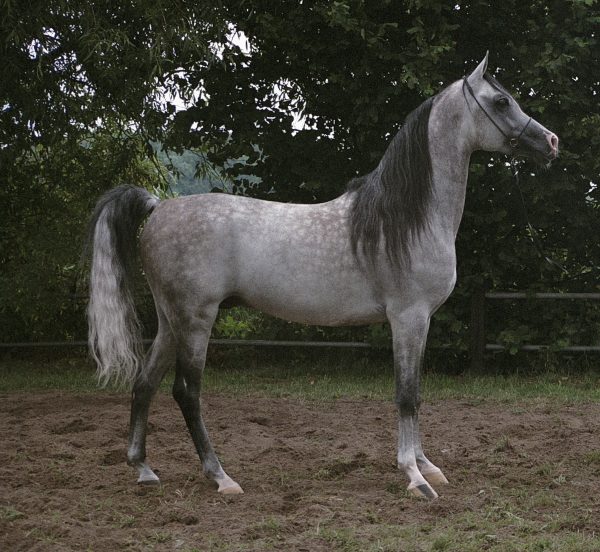
What a different type of horse among the pool of horses participating of the show. Perhaps a stallion from Eastern Europe? Wrong, the interesting line in his pedigree is Jordanian. Hlayyil Ramadan (Kamar El Zaman x Haboub), the excellent stallion from the Jordanian Royal Arabian breed is his dam’s sire. And this is the point when the mare Haboub (Bahar x Haala) leads us to the Jordanian desertbred horses.
Luckily I can get up from my desk and pick the relevant book from my bookcase. Can you? When you occupy yourself scientifically with the history of various horse breeds, then you depend pretty much on people who dedicate their lives to collecting the history of a breed and the related stories. So, since our hearts beat for the same aim, I hope HRH Princess Alia and Peter Upton pardon me when I show three photos out of their book, which show Hlayyil Ramadan’s ancestors Samiha and Madrid, as well as the related Sabal II. For any further information I would advise you to buy the book.
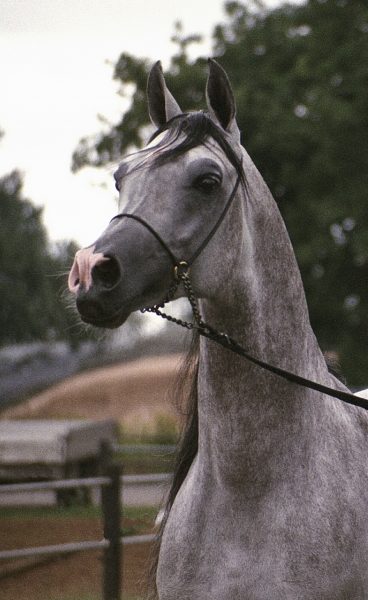
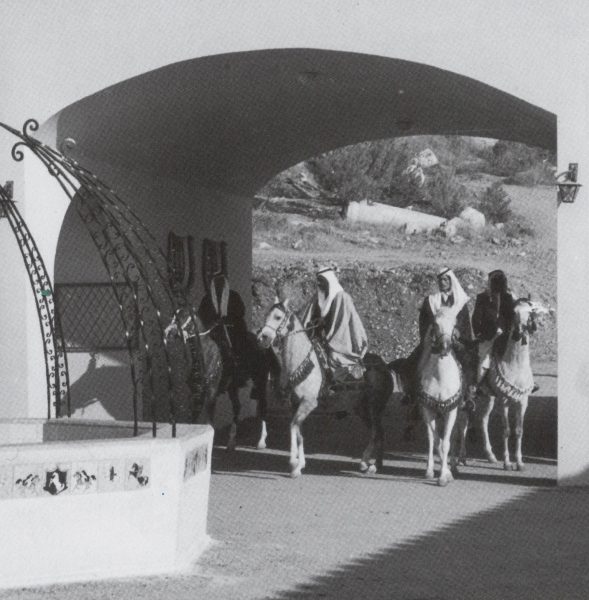
A ![]()
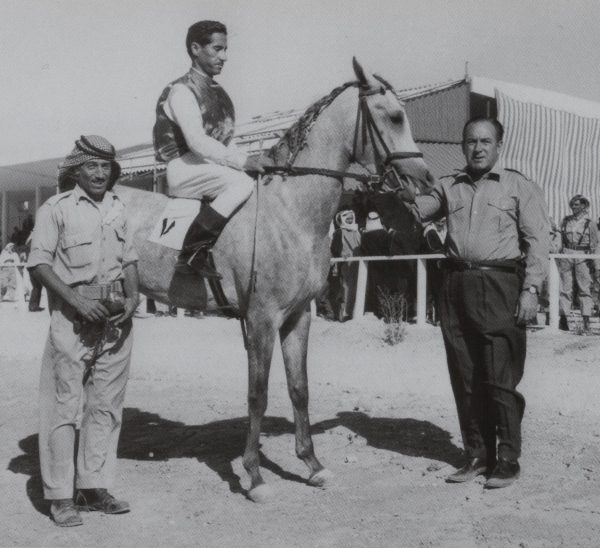
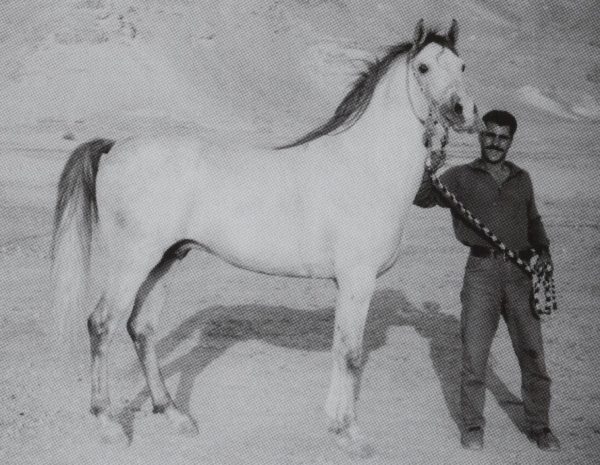
![]()
![]()
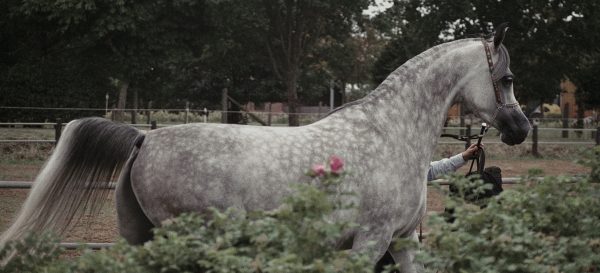
SL Blanca
Sharahm x Britny by Kula K – born 2014
Breeder: Sollidens Hästsport, Sweden
Owner: Audentia Partnerships, Belgium
Trainer: Johanna Ullström
At the European Show the score 20 for type was given only one time. And this must have been an appreciated recognition for the owners of SL Blanca who bought this classic ‘Michałów-type’ mare.
By reviewing the available photos of her ancestors, I recognised that the pedigrees of horses with likeness to SL Blanca lead to Amurath Sahib (35 Amurath II x Sahiba) or directly to Amurath 1881 (Tajar IV x Koheil III). So, undoubtedly a very beautiful classic type.
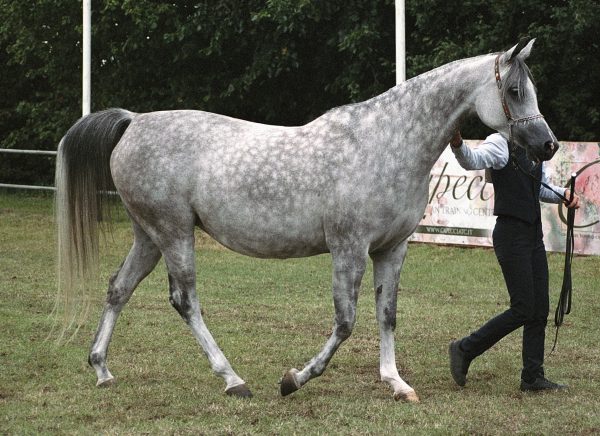
The walk of SL Blanca has the quality of a benchmark! And this although her body forms a rectangle shape and not a shorter square.
In this connection let’s recall the criteria for a good or excellent walk:
First focus the hoof print of a foreleg. Then check how far the respective hoof of the hind leg will step in or over this print. The measure is the width of the hoof and I calculate from toe to toe. The hind leg’s hoof should definitively step loosely under the body’s centre of gravity. In the above photo SL Blanca couldn’t demonstrate this any better.
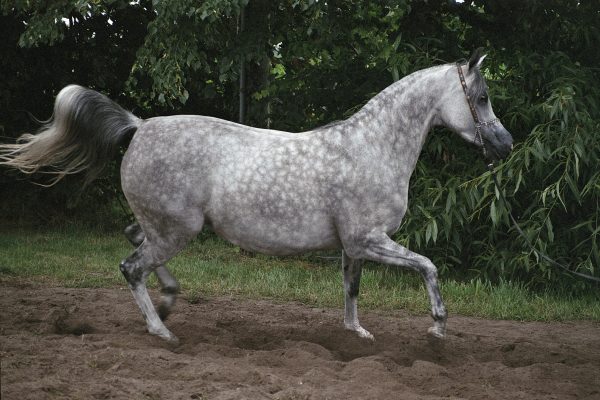
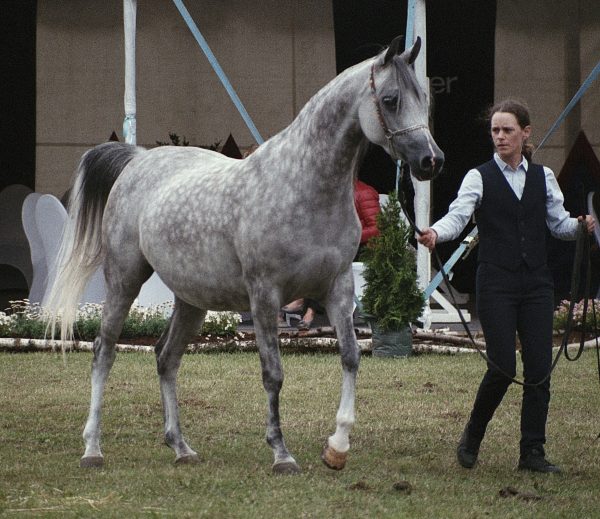
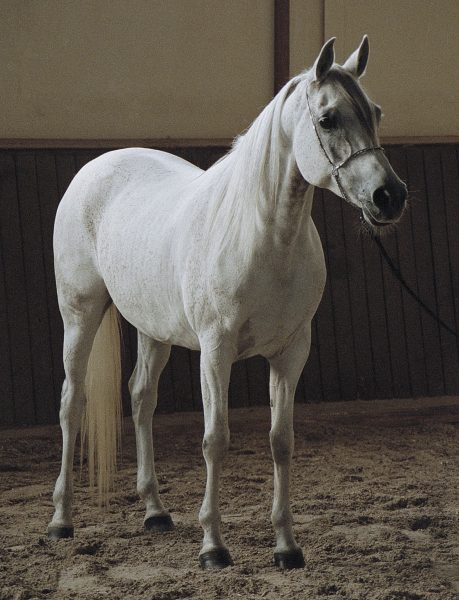
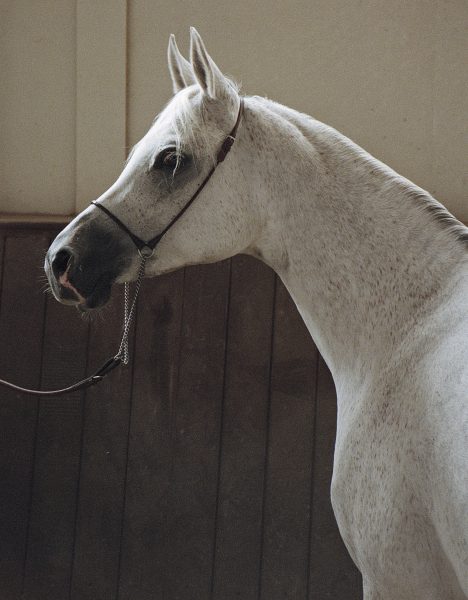
![]()
Doesn’t it seem as if SL Blanca could be the daughter of Szansa (Rusazcie x Sagana). No, she isn’t. SL Blanca is her great-granddaughter and as such also influenced by Rusazcie, the 1982 Senior Male Nations Cup Champion at Stockholm, Sweden.
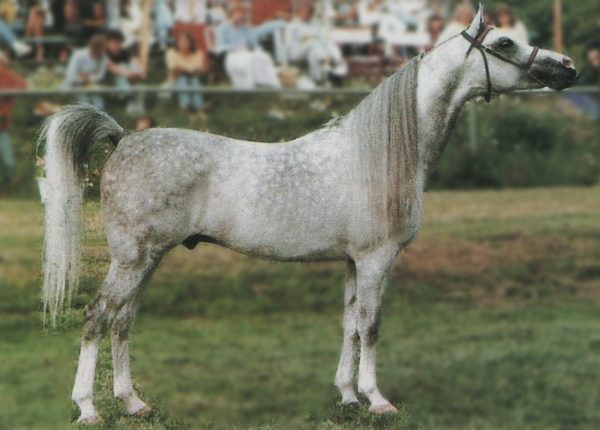
Rusazcie (Algier x Rucasja), 1974.
Photo: All Nations Cup 1980–2019, VZAP, page 23
Note by the author: You might be confused when you look up this photo in the above mentioned book. That is because this book cannot be used as reference to identify the horses! From 1980 until 2011, 43 of the 115 photos of the Nations Cup Champions were ‘mirrored’ and show all markings, mane sides and anything else on the wrong side!
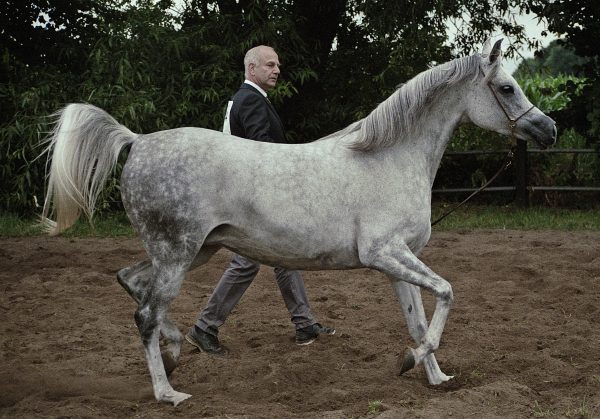
Sharifa
Kormant x Sorella by Wadim – born 2012
Breeder: Susanne & Greger Paus, Sweden
Owner: Tärenäs Arabian Stud, Sweden
Trainer: Johanna Ullström
As granddaughter of Szansa, this mare is of course related to SL Blanca, but shows the different type of the beautiful Polish mares we all are familiar with. Those cultured pearls whose genetic foundation is luckily so strong that it can remain present even after generations.
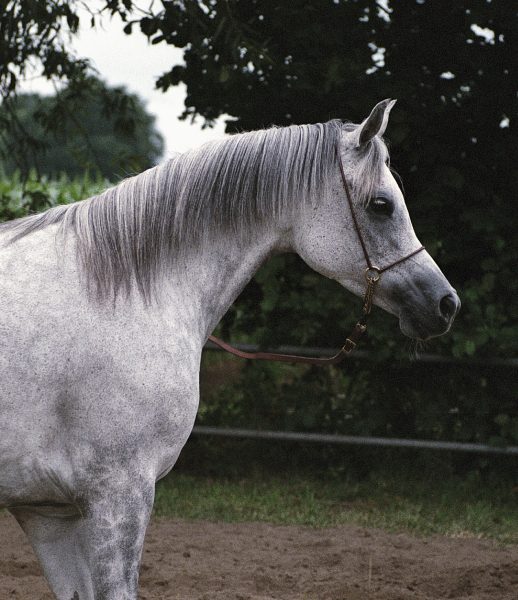
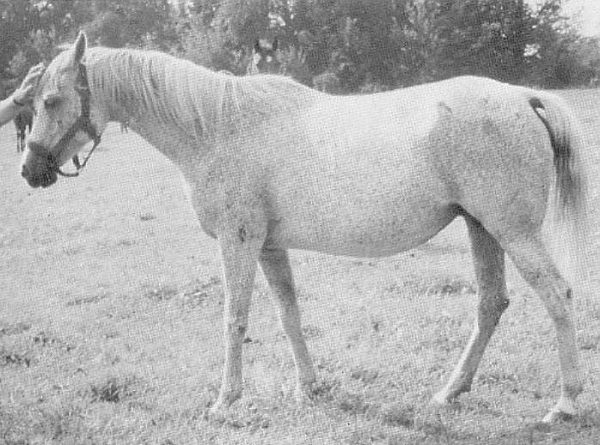
A ![]()
My favourite comparison in Sharifa’s pedigree is Engracja, who was bred by Nowy Dwór. This Polish State Stud, founded during World War II., was closed down in 1960. Several of the legendary horses of the Polish Arabian horse breed came from this stud.
And my impression is that some of the genetic heritage of the legendary Koalicja (Koheilan IV x 238 Amurath-25) is carried on via Comet (Abu Afas x Carmen) to Engracja.
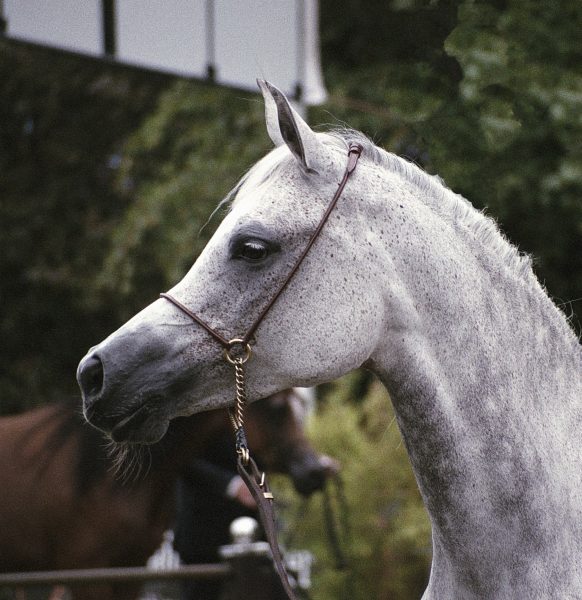
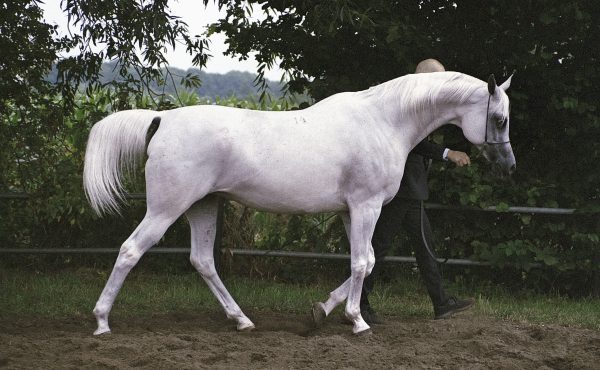
Emiriona
Grafik x Emmona by Monogramm – born 2005
Breeder: Stadnina Koni Michałów, Poland
Owner: Suweco Stud, Czech Republic
Trainer: Joanna Wojtecka & Pawel Kozikowski
Emiriona’s pedigree is an assembly of the ‘Who’s Who’ of the Polish national Arabian horse breed. So, nothing to tell about about her genetic background… But then I recognised Nemer (El Sbaa d.b. x Ninon), an asil French stallion bred at the state stud Pompadour.
Around the 1930s Prince Roman Sanguszko imported several stallions and mares from France for his stud Gumniska. Nemer’s descendant Grojec (Comet x Gastronomia) was a well-known sire in Great Britain and was later on exported to the US.
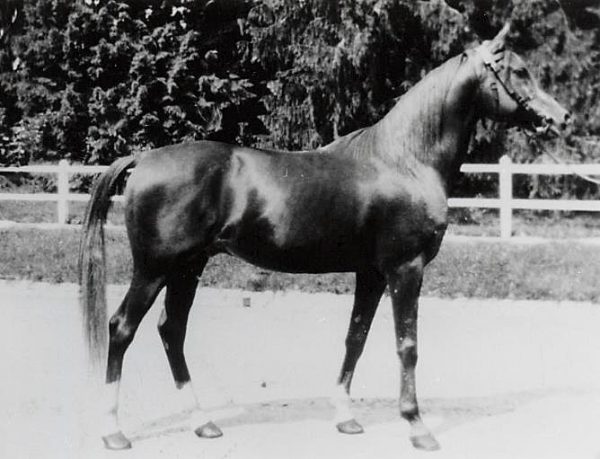
El Sbaa – a desert bred stallion, purchased by a French commission in 1925
Credit www.allbreedpedigree.com
A 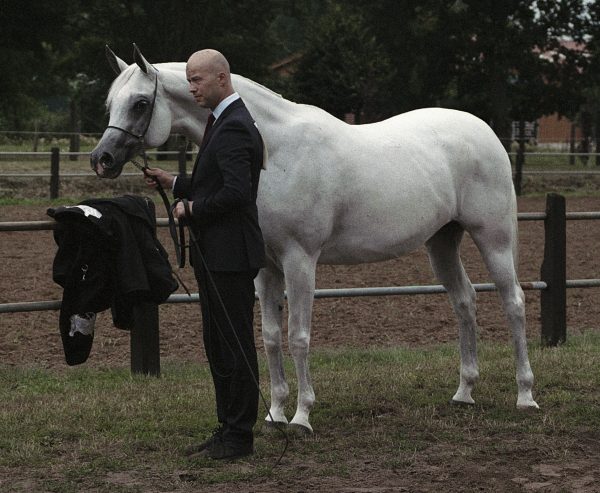
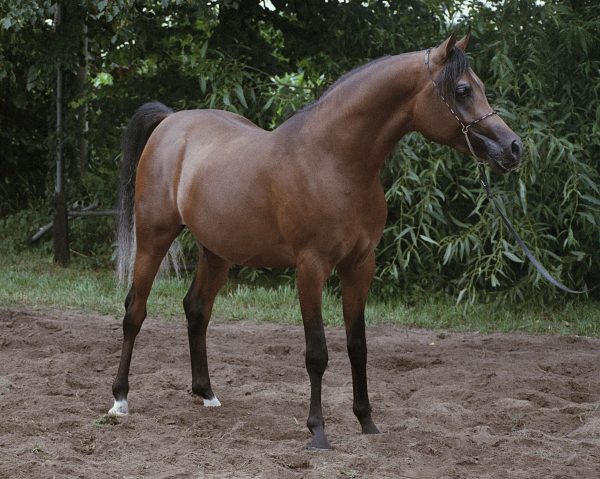
Ace Ventura
SMA Magic One x BS Aisha by QR Marc – born 2017
Breeder: Wenche Roefs, Belgium
Owner: CNC Arabians, The Netherlands
Trainer: Chris van Schalkwijk
Ace Ventura has white hair in his tail, which is quite likely an indication of the presence of at least one Egyptian line in his pedigree. In general this can also be said about white hair in a mane or roaning.
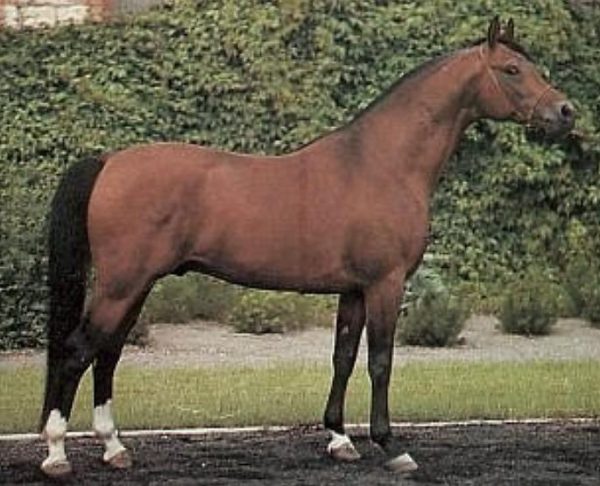
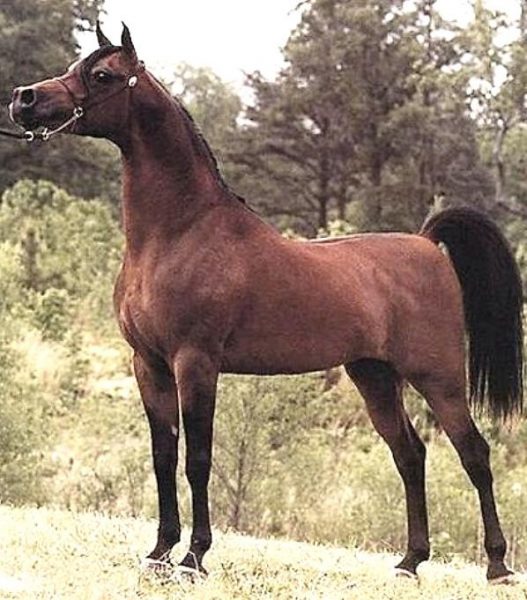


As he is just one of the many bays in the modern show-rings, I had my difficulty to extract some significance. My preferred results are Probat and Anaza El Farid, because my impression is that he combines the Polish and Egyptian type, which has been a successful strategy since decades.
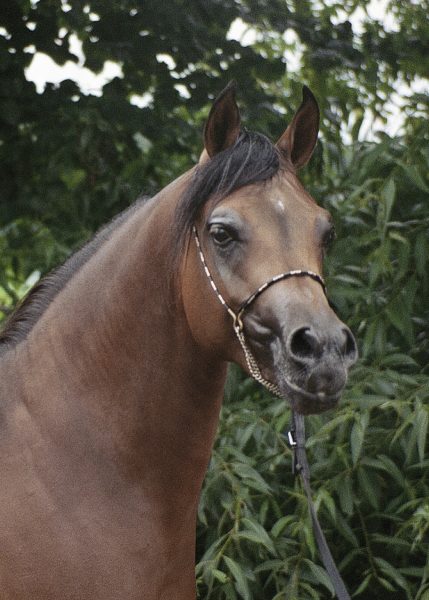
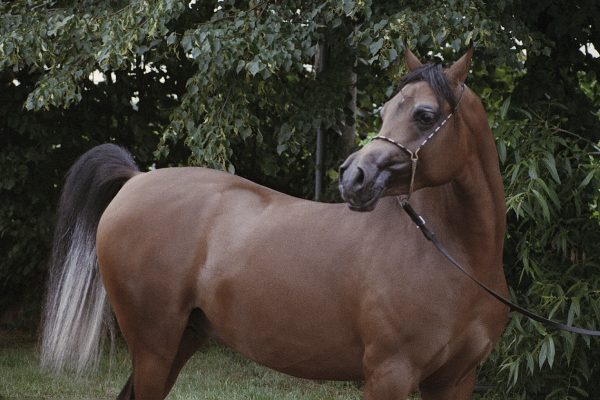
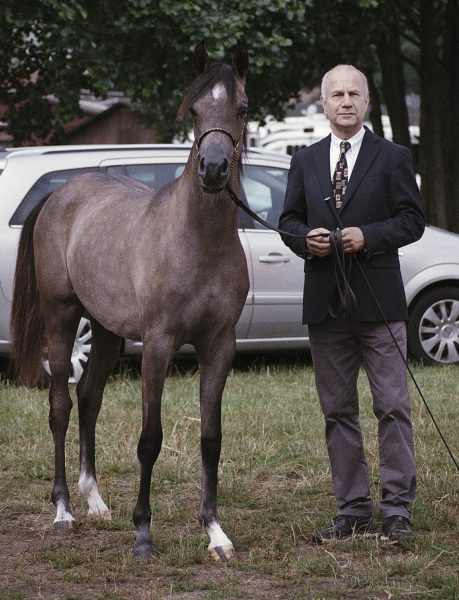
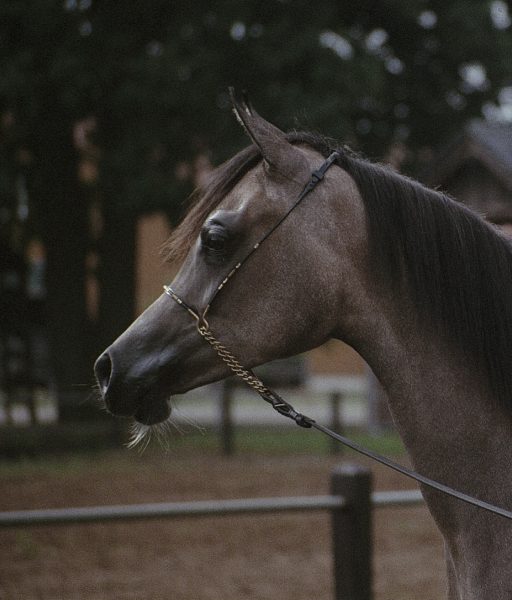
TA Katrinne
RP Burj Al Arab x TA Keilah by Aria Santino RA – born 2018
Breeder: Tärenäs Arabian Stud, Sweden
Owner: Tärenäs Arabian Stud, Sweden
Trainer: Johanna Ullström
The little TA Katrinne was just another filly at Ströhen in 2019. But since experience has taught me that the appearance of an Arabian horse can often change tremendously until the age of seven years, you have to await her growing up. It can happen that a young horse can hardly be recognised again only a few months later. Personally I would be delighted if her German ancestors and ‘relatives’ bred at Professor König’s stud in the 1980s, such as Nikonja (see below), had an identifiable influence.
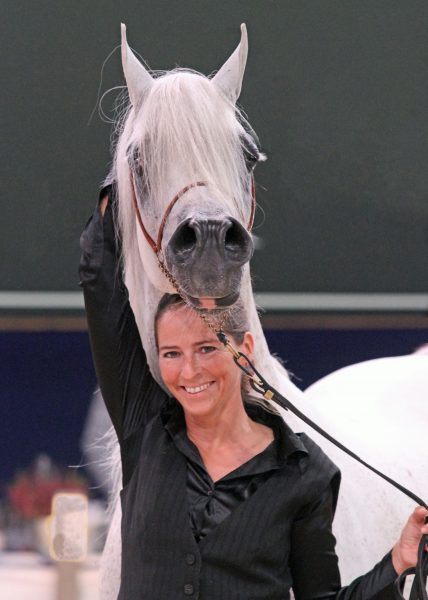
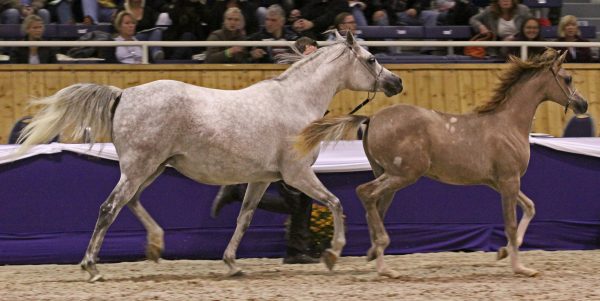
RP Burj Al Arab (by WH Justice). His nickname is ‘Burschi’, which corresponds to the Scottish ‘laddie’.
The photo left shows him at Aachen in 2019 with his ‘landlady’ Johanna Ullström and in the right photo you see him at foot of his dam Pamira Bint Psytadel (by Psytadel) also at Aachen, but in 2012. The photo below shows his grandam Nikonja (Neman x Nika) born in 1987 and presented at the show at Paderborn in 1997. All these photos are taken by Betty Finke.
A 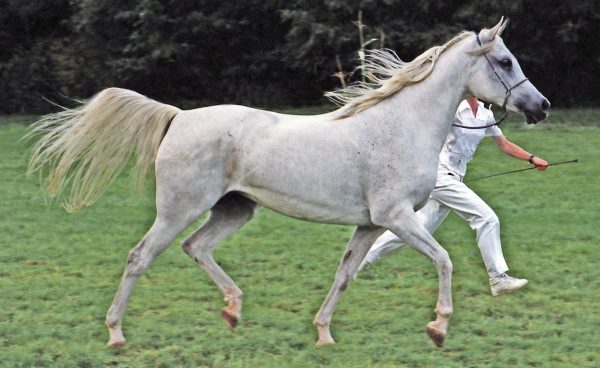
Afterword
Perhaps you ask yourself which criteria this restricted collection of these few horses is based on.
So I would like to tell you that these are the only horses I took photos of at this show.
The criteria for me being interested in taking photos were:
- No artifical blackening of the face, or
- The blackening having distinctly faded (Sadly the camera shows the fading black colouring up more strongly than expected.)
At home, when I registered the horses with the respective data, it turned out that several of the selected horses were trained or presented by Johanna Ullström.
My personal conclusion is hence: ‘Well done Johanna!’


